From at-risk dog to therapy pet in training
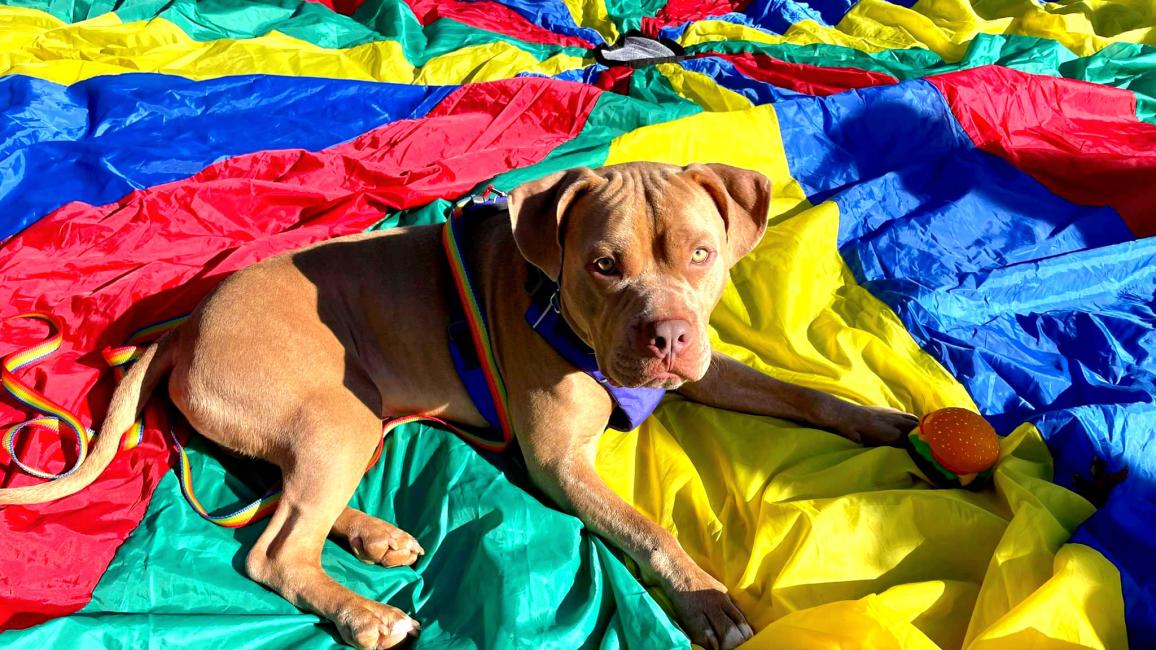
It is hard to show your best side in an overwhelming situation, and even more so without an understanding of what’s happening and why. So, when young Jake first arrived at a shelter, he was understandably overwhelmed, excitable and surrounded by new sounds and smells and faces. He never got a chance to show his best side.
Reacting intensely when he saw people or other dogs (especially if he was on a leash or separated from them by a barrier), he’d pull and jump, eager to get close to them. He was also big and strong, and he didn’t seem to have any understanding of personal space. Jake’s behavior was considered problematic, and that meant his life was at risk. But he got a second chance when he was added to a list of dogs heading from the shelter to Best Friends Animal Sanctuary.
In a quieter environment with time and space to unwind, it was possible to observe and understand Jake’s behavior. He seemed to love each new person or dog he met. His habit of pulling on the leash and jumping at barriers appeared to be a desire to play. It was true that he didn’t quite “get” personal space and that he lacked doggy manners, but he just needed the chance to learn.
Caregivers worked with Jake on basic cues such as “sit,” as well as his leash skills. They introduced him to some of his doggy neighbors to make a few friends. He even got a roommate.
Life was already looking up for the pup, but it was about to get even better. Jake caught someone’s attention, and soon he’d be on his way to being a family man and professional pooch.
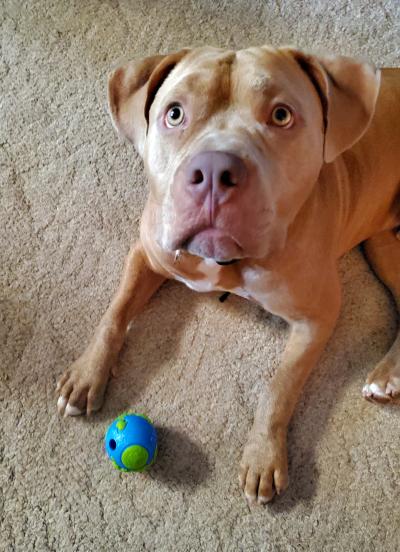
An irresistible job offer
Dr. Risë VanFleet was searching for a furry new addition to her family, as well as a potential canine therapy assistant. As psychologist, play therapist and president of the International Institute for Animal Assisted Play Therapy, Risë gives her pups the opportunity and (more important) the option to become play therapy dogs.
Play therapy involves using play, toys and lighthearted activities as a way for children, teenagers, families and adults to connect with and express their feelings to a therapist. Animal-assisted therapy, meanwhile, uses interactions with animals to help with mental, physical or occupational therapy. Animal Assisted Play Therapy (AAPT) blends the two together — play and playfulness with an engaged animal for mental health, allied health and educational purposes.
A certified dog behavior consultant with a long history of volunteering with rescue organizations, Risë is also a pretty great talent scout with a fondness for homeless pets. She was specifically looking for a dog with a different personality from her two current therapy dogs.
[Lab rescued from shelter giving back as firehouse dog]
“Everything revolves around the personality and what the preferences of the dogs are,” she says. “I’ll think about the client. This is what the client needs. I need a dog who can provide those things but I don’t want to pigeonhole a dog. I don’t want to say everybody’s going to need the same approach.”
In the midst of her search, she received a message from a friend: “I know of this great dog who might be really well-suited to play therapy.”
Susan Fishbein, a local volunteer at the Best Friends Animal Sanctuary, had just taken Jake on a sleepover. Since she knew Risë’s work from dog training conferences, she made contact to see if Risë might know someone interested in adopting Jake.
“She sent me pictures. She sent me videos. I asked for more videos,” Risë recalls with a laugh. “The more I saw, the more I liked. I also trusted her judgment … Usually, I like to meet the animals in person, but I’m in Pennsylvania (and Jake was in in Utah) — not exactly a day’s trip.”
After thinking about it for a while longer, Risë decided to make the call, adopt Jake and arrange a midpoint meeting place in Indiana.
Just like that, a dog who appeared to be almost out of time became part of a family and was headed home.
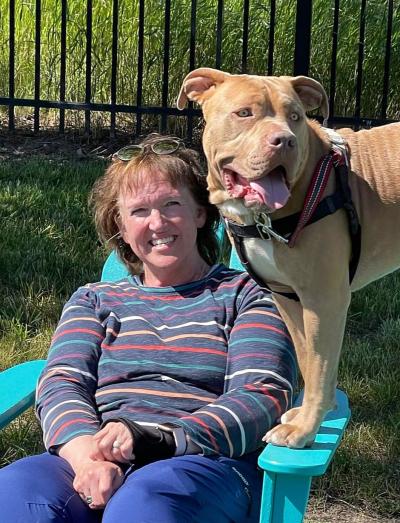
A whole new life of learning
From the moment Jake arrived at his new home, the learning began for both Jake and Risë. She watched, observed and took note of all of the little things Jake was adjusting to — things that often go unnoticed when a new dog moves in. Everything from the feeling of grass under his paws and raindrops landing on his head, to learning how to interact with all his new four-legged family members: Jake was absorbing all the new information and taking it in stride.
[Visiting pooches a big hit at Navy base]
“The other dogs liked him right away,” Risë says. She introduced them one at a time, and Jake adjusted his play style to match their energy. Soon, he was regularly squeezing onto a chair with his new brother, Murrie, and finding new, entertaining ways to contort around him and inspire a series of photos Risë calls “two dogs and a chair.”
Jake was also enamored with the family’s two cats. “The cats are not afraid of him,” says Risë, “but we’re watching carefully both for the cats’ sake and his sake.”
Both parties are interested in playing, but Jake’s play style has always been on the rough side and so they’re taking it slow getting to know each other. And Jake’s pretty content to watch the cats roll around together. He can be loose with them in the house, and he likes to sit or lie down nearby to watch them.
A lot of what Jake has been learning is about patience, politeness and impulse control. He was a whizz at whistle recall, and his tendency to barrel happily and directly into people led to another lesson on the “stop” cue. He picked up “wait” easily, along with “OK” as a release. And “back” was a piece of cake.
“I try not to overtrain my dogs, but obviously they need to learn how to live politely with other dogs and cats, and us,” Risë says. “Those are the main things we’ve worked on because most of the time is (spent) observing him, playing with him, having a good time and understanding where his limits are when he does kind of lose his mind a little bit with the over-enthusiasm — just trying to make sure we’re off to a good start.”
Risë has noticed him self-regulating more often when he gets excited, and he’s also decided to sit when he’s asked to wait. He’s quick to calm down, while retaining all of his enthusiasm for meeting new people. He’s fearless, friendly and eager to learn. And so, it appeared, he was ready for his first job.
“If my dogs work at all (and they don’t always), it’s because they want to, they enjoy it and they’re suited for it,” Risë says. “But the work is fun, and that’s part of it. It takes time to build the partnership, and Jake won’t work with actual clients for some time yet ... (but) I think he’s going to be great.”
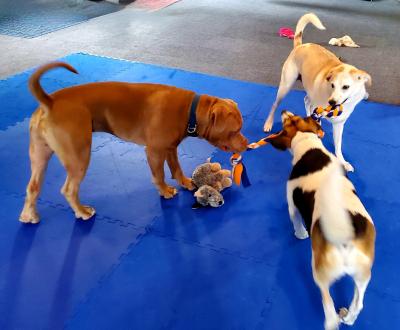
A career canine
After four months with his new family, Jake joined Risë and his canine siblings at his very first workshop. It was for the first level of the program — Animal Assisted Play Therapy: Theory, Research, & Practice — to teach the values, principles and processes used in their therapy work. The dogs were there to fill in as a teacher’s assistants.
From the beginning, Jake was a professional. He greeted each person politely in turn and eagerly joined in some of the teaching exercises. “One of our activities is to do some consent testing, where we try to do something [with him] for three seconds, stop, and see how he reacts — almost nothing that triggered him in any way,” she says. Jake also learned several new behaviors that are used in AAPT taught by the group using dog-friendly training methods.
When he wasn’t interacting with the group, Jake entertained himself with toys out of the toy box, happily tossing them around, off to the side. As soon as Risë noticed he was getting tired, she got him back home for a break, and then he was ready and raring to go the next day.
Jake got compliments on how patient he was, and he soaked up the attention like a particularly adorable sponge. For his first job, it went pretty well. He certainly impressed the boss.
“I’m really pleased with how he’s doing so far,” Risë beams with pride and care clear in her voice. “I think he’s going to be a great play therapy dog. If for some reason he doesn’t work so well with families (and so far, I haven’t seen any sign that he won’t), he’s going to be a great workshop dog.”
For now, she says, the next step is just spending more time together and watching the world — setting Jake up for success by building up a strong relationship and helping him interact with the world calmly.
Jake’s been given a second chance to show his best side, and from this angle, it’s absolutely stunning.
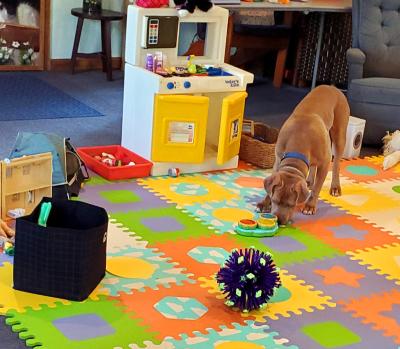
Adopt and help save lives
Visit your local shelter or rescue group to meet a dog like Jake who would love to be a part of your family.
Read more
Rescued blind dog becomes therapy dog
An unforgettable dog’s life in photos
Hercules the therapy cat goes from zero to hero to help Alzheimer's patients